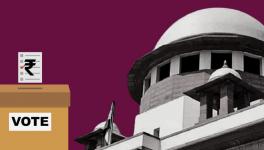Why is Maharashtra Information Commission Lowering the Bar for Transparency?

On February 15, 2019, the Maharashtra State Information Commission (MSIC) upheld an argument of a public information officer (PIO) that the Chief Minister’s Medical Relief Fund (CMMRF) does not come under RTI. The argument even left ramifications on the earlier decision taken by the state government earlier when Chief Minister’s Relief Fund (CMRF), which was declared to be under transparency law when there was an uproar of it not being under the same. When RTI applications were filed to know what went into the decision of the funds coming under RTI, or not coming under RTI, the government said that they continue to give information under RTI showing inconsistency in its stand. Activists, however, have slammed the Maharashtra Information Commission more for not being a crusader and watchdog of transparency and letting a body it judged to come across as being more willing and “choosy” in its transparency than it wants it to be. Ashutosh M Shukla delves deep into the controversy.
———-
The Maharashtra State Information Commission (MSIC), which is supposed to be the state’s guardian to uphold transparency, comes across as less willing to ensure transparency than a body it is judged for the same.
While last year the MSIC ruled that the Chief Minister’s Medical Relief Fund (CMMRF) does not come under RTI, recently the CMMRF, in an RTI reply, said that it comes under RTI and has been giving information under the same.
The inconsistency in the stand of CMMRF is questionable. Last year, MSIC argued that it does not come under RTI as it gets “private donation”. It is accused of allowing CMMRF to get away by making a show of transparency, when it suits them, and not providing information when it does not, with the latter scenario leaving little hope for an applicant.
This issue from last year became afresh after replies were received to RTI applications filed by this correspondent for both CMMRF and the Chief Minister’s Relief Fund (CMRF).
The CMMRF is considered part of CMRF. Based on the MSIC order, this correspondent had filed RTI applications with the Chief Minister’s office asking for records of the decision taken, file notings, circulars, and opinions, among other deliberations done, before deciding whether the funds should come under RTI or not come under RTI. This was because the Chief Minister’s Relief Fund was brought under RTI in 2008 by then Chief Minister Vilasrao Deshmukh. The last reply dated 20.3.2020 came recently due to lockdown.
The Public Information Officer (PIO), common for both funds, states that since both funds are under RTI, and information is given under RTI, there was never any question of such deliberations that it will not be under RTI. It also said that there was no review of the 2008 order when it was decided that CMRF is covered under RTI. However, no records that establish the reason and deliberations that bring CMRF under RTI were given, stating that all records of that time were burnt in a fire at Mantralay in 2012.
Tupe said he had filed RTI applications because it seemed that people who did not seem to be deserving were getting benefits of the fund over needy people.
So now, as a final outcome, while CMRF and CMMRF continue to entertain applications and make suo moto disclosure of some information if in future it does not provide information, a State Information Commission order can give an applicant little hope. Also, activists say that the CMMRF may continue to make a show of transparency and provide information that is convenient to them while blocking information that they may not want to share.
What is and what led to the MSIC order of last year?
Govind Tupe, a senior journalist and RTI applicant had filed an RTI application on October 27, 2016, seeking details related to CMMRF. Tupe said he had filed RTI applications because it seemed that people who did not seem to be deserving were getting benefits of the fund over needy people. He had also asked details of names and amount each beneficiary got, those recommending beneficiaries, complaints of misuse, and action taken among others.
The PIO replied to him providing information on the total number of beneficiaries and the total amount that was given as help. For the remaining, it said that information was “voluminous”. The names of the beneficiaries were not provided citing exemption under the RTI Act of being “personal” and shared under “fiduciary relationship”. Tupe approached the State Information Commission in November 2017.
When no one attended the hearing, the commission issued show cause notice. The Secretary to the Chief Minister even wrote to the panel stating that all information has been given and only the exempted information has not been provided. One of the Commissioner’s retired and follow-up hearings happened only in 2019.
However, when the final order was passed by MSIC on February 15, 2019, it upheld the PIO’s argument that CMMRF is not a public authority under RTI Act as it gets “private donation”.
“When the hearings started again after the new commissioner took charge, it kept getting differed as the government said they had asked for the Law and Judiciary Department’s opinion. I was under the impression that one more hearing will be held but then I got the order directly. In that order, the commission upheld the argument put forth by the PIO that CMMRF does not come under RTI because it gets ‘private donation’. Never before did I hear this argument from the PIO during the course of the hearing or else I would have countered it. I got to know of their argument that they are not under RTI through the Commission’s order. I did not like the order but I did not have the capacity to contest it in the court. The order does not even mention the law,” said Tupe on the 2019 order.
Fadnavis did not reply to the criticism and this left it for the government to decide on what and which information to give.
The Devendra Fadnavis’s government, under whose tenure CMMRF was created, argued that it was not under RTI. When contacted, in an SMS reply, he said, “A file was put up before me that it has been the consistent stand of the Government that it doesn’t come under RTI since it doesn’t get funds from the Consolidated Fund. Although it was a principle stand, I however wrote on the file that information can be given since we have nothing to hide, without mentioning that it is given under RTI. The second reservation was that the name of the patients receiving aid can’t come in public domain without their express permission. Since a concurrent audit was done regularly there was total transparency. This government has stopped helping patients and has closed the scheme hence I don’t think they have any info to give. However, if the government feels that they want to change the principle stand then they are well within their power to take the decision.”
Fadnavis did not reply to the criticism and this left it for the government to decide on what and which information to give.
Chief Minister’s Relief Fund surrounded by controversy
The CMRF, as a public trust, was set up on March 2, 1967. The Fund provides financial or other help to needy persons affected by natural calamities, communal riots, terrorist attacks, and patients suffering from diseases. It also extends financial help to institutions and construction of buildings for educational and medical establishments as per details on its website. Managed by the State Government under the chairmanship of the Chief Minister, the fund is administered on an honorary basis by the Principal Secretary to the CM as Secretary of the fund.
As soon as the RTI Act became effective, Shailesh Gandhi, former Central Information Commissioner, sought information on the Chief Minister’s Relief Fund. When he did not get information, Gandhi approached the State Information Commission. The hearing kept getting delayed. Due to an unprecedented row, the then Chief Minister Vilasrao Deshmukh decided to publish all details on the website in 2008, and the same was communicated to the Information Commission.
The website provides monthly reports on money given to hospitals, donation reports, disease wise report, and donation to CMRF, financial aid to medical, natural and unnatural calamities and death and among others. The website, however, does not have details of beneficiary names, the amount each beneficiary received, and the people who recommended the beneficiaries before they got the help that Tupe had sought and activists feel is crucial for transparency.
The website makes some suo motu disclosure of CMRF but no separate details of CMMRF are given.
As per the website, donations between Rs 21-25 crores were received each year between 2015-16 to 2017-18. Details for 2018-20 are not updated. From January 2020 to August 2020 over Rs 326 crores from 42,027 donors were received for CMRF, CM Farmer Relief Fund, CMRF COVID-19, and CMRF Drought – 2015.
What is the Chief Minister’s Medical Relief Fund (CMMRF)?
Unlike the CMRF, the CMMRF came into existence on August 23, 2015, when Devendra Fadnavis was Chief Minister of Maharashtra. It provides financial aid to the needy requiring medical help. The Fund is looked after by the same set of people and the same PIO as that of CMRF. The website makes some suo motu disclosure of CMRF but no separate details of CMMRF are given.
Government officials say that there is no such segregation that is provided. The website instead mentions medical financial assistance given year wise from 2015 to 2019. In this period, a total of 53,762 patients have been given help of Rs 528.83 crores. The website provides a separate head for COVID-19 and the money it got from donors was over Rs 314 crores till July. In the month of July alone it gave Rs 23.21 lakhs for medical treatment.
Officials at the state’s relief fund said that as proof of their transparency, they even gave information on an RTI application. However, this information does not include the one that was denied to Tupe.
The government maintains that such information cannot be given and that they have maintained transparency. As per that reply, the government last month stated that it received over Rs 341 crores for COVID–19 more and spent over Rs 72 crores. The updated figure now stands at over Rs 540 crores received for COVID-19 compiled till August 12, 2020, and expenditure for the same time stood at around Rs 128 crores. Much of the expenditure money, said officials, was given to medical institutions to know how to go about tackling the pandemic.
MSIC “killer”, not “crusader”, of the transparency law, say, activists
Shailesh Gandhi, former Central Information Commissioner, said, “The replies from CMMRF seem to indicate that they are not willing to be more transparent than the SIC wants them to be. It should be the other way round. The Commission acted like a killer and not a crusader of transparency. Its order allows the government to be transparent to the extent it suits them, and not when it does not. The commission in its last year’s order should have first dealt with CMRF by going into the details of what makes or does not make them a public authority instead of just mentioning and upholding the PIO’s argument at the end of the order. What Tupe was denied, should be suo motu disclosure.”
“Almost all officers who look after the fund are government officers. The SIC order should have dealt with the issue of CMRF and what makes or does not make it a public authority before moving on to CMMRF. How can it be that CMRF was under RTI and not CMMRF” said Gandhi.
Gandhi, who is a respected figure for the principled stands he has taken, said: “The present chief minister should come forward and suo motu declare the name of beneficiaries and those on whose recommendation they were given benefit. I can understand disclosing the disease’s name of a person could be a problem and can be exempt. But the name of the patient and the amount given should not be a problem. This is, infact, a requirement under suo motu disclosure of RTI Act under Section 4 (1) (b). Such information should be given along with the money spent. Right now it is like they are transparent to the extent it suits them, and not when it does not. This leaves little scope to an applicant.”
Gandhi’s views found support among some other activists as well. Bhaskar Prabhu, another RTI activist whose organisation Mahiti Adhikar Manch works to make RTI popular, said: “It is an expense that is given through exchequer and is public money. In case donations are given, once it comes to the government it is public money. The CM should take cognisance and suo motu declare those details. If in future, under RTI, details about former Prime Minister Manmohan Singh are sought, his medicine details may not be given as they will give away disease but his medical allowance details have to be given. There should be transparency. Name of the MLA or whoever has recommended beneficiaries should also be given and need to be published for transparency on the website.”
Efforts to reach out to Chief Minister, Uddhav Thackeray, for comment did not get a response. Sumit Mullick, the Chief Information Commissioner who had passed the order, chose to not respond when approached for comment. This story will be updated if they respond.
(Ashutosh M Shukla is an independent journalist based in Mumbai.)
The article was originally published in The Leaflet
Get the latest reports & analysis with people's perspective on Protests, movements & deep analytical videos, discussions of the current affairs in your Telegram app. Subscribe to NewsClick's Telegram channel & get Real-Time updates on stories, as they get published on our website.






















